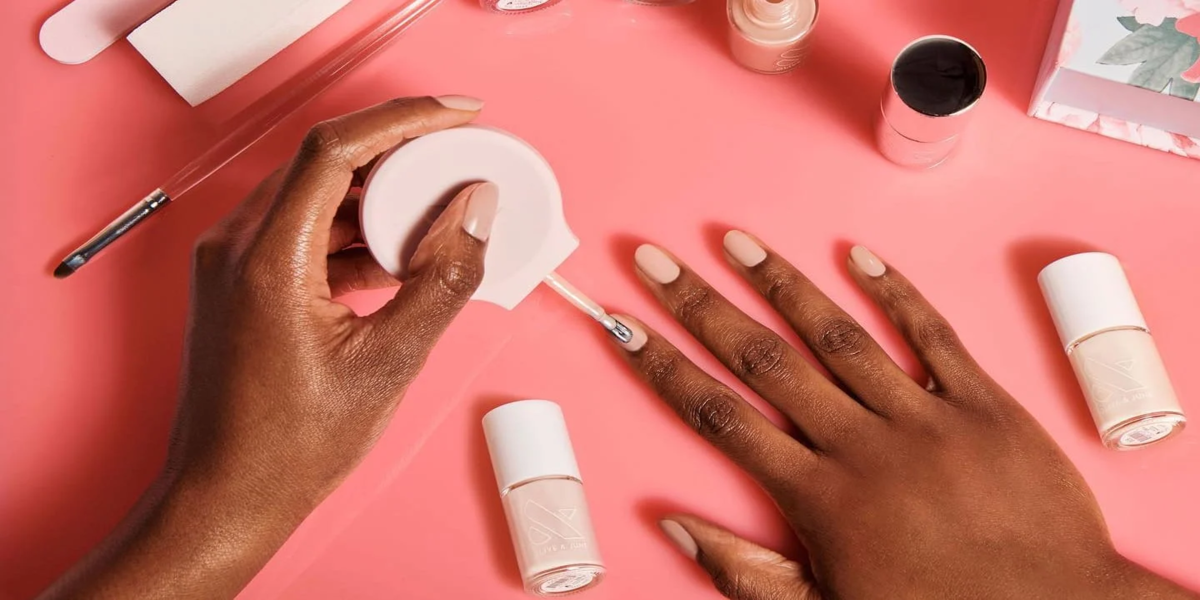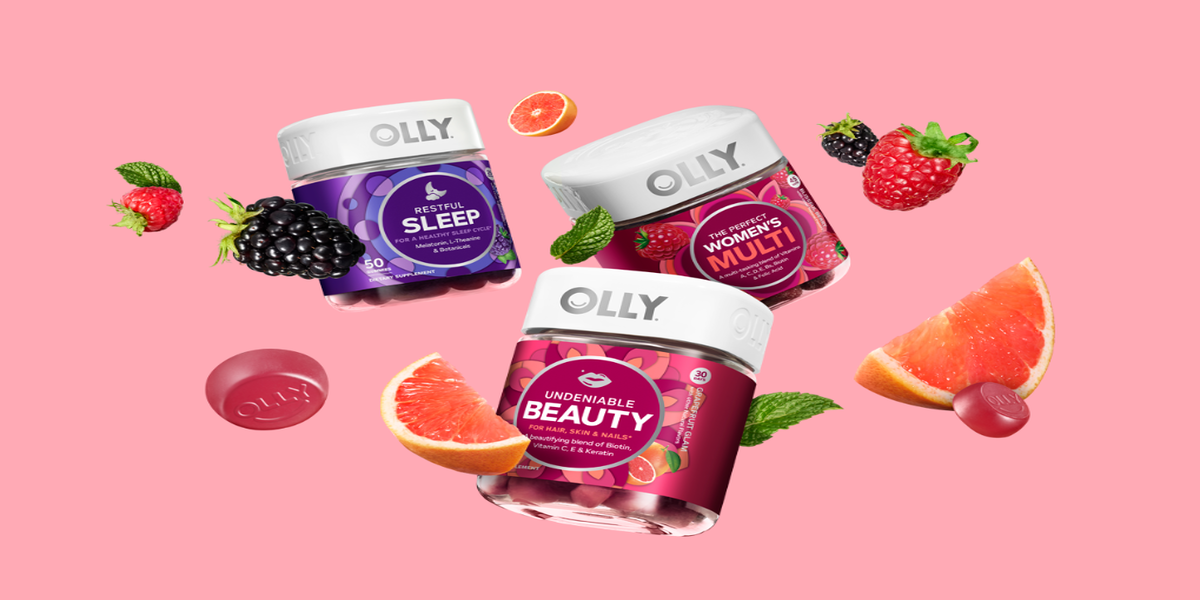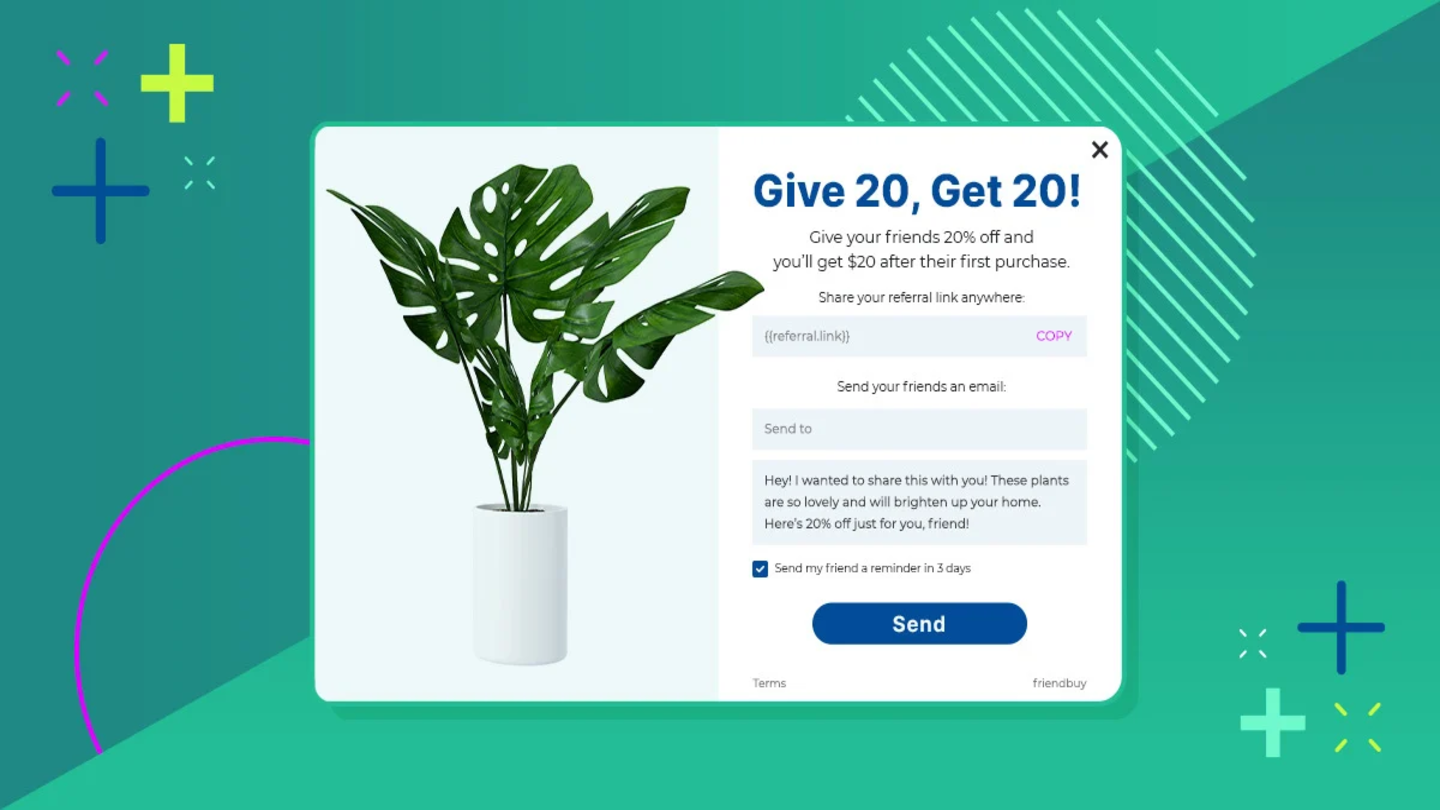Share this article
Table of Contents
Even with a powerful customer referral platform in place, there’s still one fundamental question. How do you get customers to want to refer you to a friend?
Answering this question will be the difference between a robust customer referral program and, well, crickets. So let’s dive into the art of getting referrals.
Set Up An Enticing Refer-a-Friend Program
Every good refer-a-friend program has to work from both ends:
- Advocate – Your advocate is the individual responsible for promoting the referral program and hyping up your offerings to others.
- Friend – This will be the new customer your program generates.
Think of these two roles as two gears in an engine. If one doesn’t work, the whole car stops. Both ends need incentives to take action if your refer-a-friend program is going to run smoothly.
In the example above, Olive & June creates a referral program that works both ends. Give $10 (as in dollars-off for the Friend receiving the referral) and get a free bottle of nail polish (as the Advocate). Both incentivizing offers are clear—and even stated in the landing page headline.
How can you build yours in a similar way? We’ve covered a lot in How to Build a Referral Program, but let’s focus on the fundamentals of Advocate rewards and Friend incentives.
- When you set up an Advocate reward through Friendbuy, you can select incentive options like coupon codes, account credits, gift cards, or Shopify coupons. You can also choose “other” if you have company-specific rewards like free swag.
- For your Friend incentive, your options are just as wide. The key here is choosing when to trigger the reward. That’s ultimately what your referral program is paying for. Don’t be afraid to set a high bar. Some brands, like Herbivore, only trigger a reward when the friend buys at least $75 in goods.
The key here is to make sure the incentive and the reward work in unison. It is a synergistic relationship. For example, if your trigger for a successful referral is that a Friend has to buy $500 in goods, that’s going to be too much. You’ll put off the Advocate before they even attempt to refer a friend.
But when you get Advocates and Friends working with each other, you win. Here’s how to do it.
Choose rewards worth sharing for
Assuming your business has done everything in its power to impress customers, the question still remains. How do you get a customer to want to become your Advocate?
The formula is simple. Create a compelling refer-a-friend program. That starts with choosing the most urgent incentive for your Advocates as possible.
According to some statistics, a direct incentive is responsible for half of all referrals—prompted or otherwise. For your Advocates, that means creating tangible rewards they can put to use immediately:
- Coupon codes
- Account credits
- Gift cards
The key: Advocates want to see that reward show up in their account as soon as the referral’s made. The sooner the referral, the more likely they’ll take action and prompt a friend to sign up.
Choose incentive triggers worth joining for
The Friend incentive is also a partial incentive for the Advocate. After all, no one receives their reward until the Friend signs up. But maybe you don’t want to pay for a signup. You can trigger a reward as soon as a Friend does any of the following:
- Makes a purchase with a minimum value
- Signs up for your service subscription
- Joins your community by entering an email address
The first two incentive triggers require the Friend to convert into a paying customer, while an email address simply converts the Friend into a lead.
And keep in mind that if you’re using a “double-sided” incentive program—rewarding both Advocates and Friends—none of it triggers until this conversion point. This is where you’ve got to make the incentive—what you’re offering—come alive.
Automate Your Referral Program Promotion
As manual as the process might feel in the beginning, there’s nothing better than automating your referral program. Setting your brand’s promotion on autopilot and watching as the brand trust builds is the marketing version of a chef’s kiss.
Below, we share more referral program examples so you can see how it’s done.
On your homepage
The best way to start automating? Put it on your homepage. Make your referral program the most obvious part of your marketing outreach. Take Herbivore Botanicals’ popup, for example, which offers 20% discount codes when you refer a friend who buys at least $75 worth of goods.
Note how little friction there is for the customer. Herbivore even provides a referral script, so customers don’t have to come up with what to say. They simply add in an email, click share, and voila—they’re in the referral program.
On a Website banner or ribbon
Don’t want to lead with the referral program? Then at least keep it in a prominent place with a website ribbon. Note the “refer a friend” banner on the left side of the myxfitness homepage. It’s not invasive, but it’s not invisible. And once you click on it, it activates a landing page promising $50 Visa gift cards “for every friend you refer.”
According to our data, the above banner represents 46% of all referral marketing revenue—just from that single placement. If you want your offer to be just as engaging, consider referring to these call to action examples or different techniques for your CTA button design.
In a quarterly email blast
Your referral email blast should be a kick in the—well, needless to say, it should be a gentle reminder to your customers that referring a friend will mean rewards from your brand. You don’t have to reinvent the wheel here. Use our refer-a-friend email template to get started.
In a post-purchase email sequence
Is there a better place to engage customers than after they’ve decided to trust you with their dollar? We’re not sure. Your post purchase email is a chance to upsell them on your referral program when they’re at their most enthusiastic. Take advantage! Like Homer in the example above, make the post purchase email referral easy for them. Write customers’ scripts and let their referral be as easy as entering a friend’s email and clicking “send.” Your referral program will do the rest.
After a positive review
If nothing else works, bribe them! In a legitimate way, of course. You can use automation to reward people who leave you positive reviews. Simply set the positive review as the “triggered action” within Friendbuy. At that point, you can send the user to their rewards page to start enjoying the incentive you’ve set up for them.
See how we automate this process for you with our Yotpo integration.
After a Positive customer experience
Let’s look at the other side of the referral program for a second. Sending a referral after a positive experience is another great triggering action for your referral. Look at the example above and how it highlights the friend’s testimonial.
While you can offer your users a script so they don’t have to write anything themselves, those who do write something will have done so at the ideal time—after they’ve had a positive experience with your brand. A customized note makes the outgoing “refer-a-friend” email that much more engaging.
On social media
Of all the customer acquisition strategies that work, a social media referral program is the most public. A happy user isn’t just sharing a link with a friend—they’re sharing it with their hundreds or thousands of followers. Notice the “Facebook” tab in the example above. Your referral user flow is just one click away from someone feeling incentivized to send out a link to just about everyone they know. How might that impact your bottom line?
During holidays and sales events
The offer above has a built-in expiration date: December 25. Building scarcity into your offering is one of the simplest referral marketing holiday ideas available. Some customers might put off a referral when they think they can bookmark it and return to it anytime. But a one-time holiday promotion coincides with the theme of giving—and just so happens to have a countdown timer baked right in.
With rewards-based programs
Not all referral rewards are for individual customers. Imagine your brand with an army of brand ambassadors working for it. To achieve this, try to think of your rewards-based referral program as a business.
In the example above, Persona tells people how to become a “Persona VIP Advocate.” This opens up an entirely new way of thinking about your referral program, wherein you can recruit:
- Creators, who help your brand via influencer marketing
- Brand ambassadors, who tout the quality of your products or services to their followings online
- Affiliates, who are incentivized to sell for you from the commissions they earn
From there, your referral program becomes more than a friendly way to reach out to more customers. It becomes a way for your brand to become a self-reinforcing mechanism of marketing success.
Things To Get Right Before Getting Referrals From Customers
A good referral program isn’t slapped together at the last minute. It’s built from a solid foundation, including a robust platform, a thorough understanding of marketing techniques, and in-depth insights into customer thinking. That’s why before we talk more about the end-game, we should first address what you have to do if you want advocates to consider referring you in the first place.
Below, you’ll see the specific tips you can put into place that will set up your referral program to be a success—even before you launch the referral program.
Improve customer service and support
First, think about why customer referrals make customers four times as likely to buy. Is it because customers trust the word of someone they know? Sure—social proof is a big part of the sales pitch. Most people don’t go around making constant recommendations. When they do, others tend to assume there was a great customer experience behind it.
That’s why your first job is to create a customer experience with great customer service and support. We’ve talked about great ecommerce customer service before, but let’s get specific about what that looks like in the real world.
- Be personal with interactions – The most helpless experience a customer can have is that of being a cog in a giant machine. Ignore them at your own peril. This even applies to angry customers—be personal and reach out. According to a Harvard Business Review study of social media customer service, “prompt and personal customer service does indeed pay off — customers remember good and bad customer service experiences, and they’re willing to reward companies that treat them well.”
- Make your customer service team accessible – Zappos CEO, Tony Hsieh, even said, "Customer service shouldn’t just be a department, it should be the entire company." Customers appreciate customer service teams who are available. Even if you do a great job of treasuring each customer interaction, some customers are going to bow out after 30 minutes on hold before they ever find that out about your company.
- Ask customers for feedback—and apply it – No one wants to feel out of touch. Take Athletic Greens, which acknowledged customer feedback on taste and started sending out customer emails for blending their nutrition supplements into smoothies. Over time, using customer feedback creates fewer problems and enhances every customer experience before they ever reach out to you.
- Thank your customers – Is thanking that powerful? Not exactly. But treating your customers like they’re people and not numbers on a screen is always going to go over well. Take Ursa Major’s “About Us” page, which includes a photo of the founders, their handwritten signatures, and a brief thank you. Done well, a simple gesture reminds people that you’re human too.
- Keep your customers in the loop – You can be polite as you want, but if you don’t tell customers what’s happening, they’re not going to appreciate being out of the loop. When building a referral program, make sure your Advocates know exactly when a referral triggers their reward. If they don’t know, they’re going to wonder if you’ll ever reward them.
- Look for opportunities to go above and beyond – Think about things from your customer’s perspective. How will your service improve if you give them what they want? That’s what Imperfect Foods (above) did. They knew customers wouldn’t want some products in their default boxes. So they built that knowledge into their app, giving customers the option to click “No thanks!” on specific items. In other words, find your customers’ objections—then build your solution right into your service.
- Be generous with your customers – Nothing leaves a good taste in customers’ mouths quite like some generosity on your part. Call it a form of legalized bribery: sometimes, it helps to buy their love. Think of it as an investment, as 83% of companies who make customers happy report increased revenue.
- Share discounts and sales – This is a specific way you can be generous without doling out refunds left and right. Share discount codes and upcoming sales with customers to keep them in the loop. It will still feel like a “freebie” on their end, but you won’t have to make a bank-breaking investment.
- Give refunds with little friction – When worst comes to worst, your customers need to at least feel that you are willing to help them out, even if you can’t solve their problem in a specific way. A refund is one way to do that. More importantly, make it easy to receive the refund—like refunding the original payment method—to reduce further friction that will just add to their frustration.
Manage your brand reputation
The word “brand” simply refers to the customer’s perception of your company. That’s it. You don’t have to look for anything more complicated than that. As such, your brand’s reputation will impact every aspect of what your company does online—but especially its bottom-line revenue.
You may know this, which is why you know how important something as simple as a referral widget can be to improve the reputation of your brand. But is it enough to build good word-of-mouth via referrals? You also need an active approach to reputation management.
After all, 90% of consumers read an online review before purchasing. That should make you ask: When someone sees your online reviews, what are they reading?
Manage reviews and (genuinely) respond to negative feedback
Online reviews are the currency of your brand’s reputation. 74% of customers say a positive review they saw online increased their trust in a business. It’s not a big leap to say that every negative review—every dent in your reputation—will have the opposite effect.
No one wants negative reviews. But by responding to them and showing your brand as reasonable and concerned, you at least demonstrate that you’re on top of them. Remember, it’s not always about the negative review. It’s about what your response says to anyone else researching your brand.
Manage your reputation on Google, Yelp, G2, and more.
Google, Yelp, TripAdvisor, and other popular review platforms are the battlefields of brand reputation. They’re where you can earn—or lose—a reputation as a great brand.
For example, if you offer software—like Intuit Quickbooks—then ratings on TrustPilot and G2 will be key to your reputation. See what you can do to engage with these platforms and offer as much context and background information as possible. For example, at G2, you can see QuickBooks online has “claimed” its seller page:
This makes it possible for QuickBooks to start collecting reviews and creating a profile within G2. It can then funnel prospective buyers to that profile, where G2’s third-party reviews help provide the social proof for QuickBooks.
If you offer something that isn’t a good fit for G2, then seek out the other popular platforms—like Yelp or Google Reviews—and start taking charge of your brand management.
Remember, it’s not just the quality of the reviews here that counts. It’s also the quantity. Nearly 3,000 reviews for QuickBooks Online constitute a massive sample size. Inherent in that large sample size is a product’s popularity. If there are a lot of reviews, a customer will assume there are a lot of other people buying it. Ideally, this sample size would come with a 5/5 average, but that’s unrealistic, even for the most dedicated brands.
Oftentimes, customers aren’t looking for pristine-perfect customer reviews. They’re looking for legitimacy. They want to see that you’ve had customers and that a large enough percentage of these customers had a good experience.
Most importantly, customers want it from a third-party site. Try as you might to pump your brand’s reputation up on your referral landing page, many customers will check out a third party before they decide how they feel about you.
Think of this as the online brand reputation stamp of approval. And if you don’t do what you can to manage your reputation on these sites, you’re missing out on one of the most valuable purchase cues in the digital world.
Manage your profiles on social media
If a tree falls in the forest, does it make a sound? Now, the relevant question is: What happens to a brand that doesn’t Tweet, let alone have a social media profile? Social media is so ubiquitous—some four billion of us now use it—that we have to wonder what’s wrong.
We don’t just mean Twitter, either. Take SmileDirectClub’s TikTok strategy, which has its creators and brand ambassadors making movie references right along with millions on the platform. It’s a case study in tailoring the message to the appropriate medium. For example:
@smiledirectclub Couldn't be us. When you choose SmileDIrectClub you pay up to 60% less than braces.* #smiledirectclub #clearaligners #straightteeth ♬ original sound - Smokey
To do this, SmileDirectClub engages with Emily Watson, a creator with a penchant for tracking the latest trends and building content to match what audiences are doing. And it’s not all fun and games—SmileDirectClub also engages with medical professionals to create informative content.
This isn’t just to gain attention—although that helps. Think of your social media followers as social proof. If someone searches for your brand and finds you have an engaged following on Twitter and TikTok, they have a reason to trust that your brand is appealing to other people.
If you don’t have much of a social media presence, you can use a social media referral program to spark some action. And don’t forget to promote your referral program on your homepage to give it the visibility it needs when your followers come to check out your website.
Get your product or service right
Even if you do all of the above, there’s no substitute for a great product or service. One study even found that hotels with quality defects—a cosmetic issue in the exterior, for example—tended to earn about $3 less per room, everything else being equal.
In other words, customers will always have shrewd eyes for quality. And word gets around—that’s probably why you’re seeking out referral program best practices in the first place. The good news is that if you get your product or service right, you’ll want word to get around. Here are some ways you can do that.
Be better than your competition
There’s an old saying about being chased by a bear. You don’t have to be faster than the bear. You just have to be faster than the person next to you. That’s the approach of “be better than your competition.” Do you have to craft the perfect email blast? No. Just build a better email blast than your competition.
It may be easier said than done. Take Walmart+, the big-box retailer’s answer to Amazon Prime. Walmart+ knows that to get its foot in the door with many customers, it can’t roll out its premium subscription service at 150% of Amazon Prime’s price. So what did they do? They went the other way—just low enough for double digits per year, offering a stark contrast with its competition.
It’s less about beating the competition than it is about the power of contrast. How do we measure quality? By comparing one product or service with another. If you can position your products or services in a similar way—isolating variables and trying to beat the next offering—you’ll gain a reputation as the go-to quality offering in your field.
Keep your existing customers happy
What determines product quality? It’s hard to measure, but here’s one way you can do it: Look at your customer retention.
That’s what NatureBox does. NatureBox hasn’t only invested in the products it includes in its healthy snack boxes, but actively tweaks its product offerings to respond to customer demands. According to Zendesk, NatureBox’s 19,000 customer support tickets were getting unwieldy, which made it difficult for NatureBox to create the perception of quality it needed.
NatureBox experimented with omnichannel customer service to keep its customers happy. And there they found a key insight: Incorporating customer chat reduced customer call volume by 60%. NatureBox had found a way to keep customers happy without customers knowing why they were so happy. This reduced customer churn and the overall number of tickets the company had to deal with every month.
Make your brand memorable
When Dollar Shave Club was still trying to cut out middlemen and penetrate a still-burgeoning Direct-to-Consumer market, they needed a way to express that their brand was different from buying razors in a store. To do so required something disruptive: They would have to change customers’ habits.
Enter “Our Blades are F***ing Great,” an advertising campaign that used razor-sharp humor and straightforwardness to cut straight through to the consumer. But a well-written TV spot was just part of the strategy.
Dollar Shave Club also priced its cheapest options as a sort of foot-in-the-door. It didn’t matter if the products weren’t profitable right away. By signing people up for their first razor subscription service, Dollar Shave Club began building long-term brand value.
From there, it was simply a matter of optimizing for customer retention and continually reinvesting in its brand reputation and product quality. But before they could do any of that, they had to make themselves memorable enough for grocery store razor shoppers to give them a try.
Be an industry leader
What does it mean to be a leader? It usually means you’re the first one through the door. That means you need to be daring, innovative, and creative if you want to get a reputation for being an industry leader—and get people raving about your services to their friends.
What does that look like? Consider Tuft & Needle, one of the first mattress companies to offer a DTC approach. Before brands like Tuft & Needle, mattresses were something consumers felt they had to try themselves—usually in large retail spaces. Tuft & Needle, noting that “the mattress industry hadn’t changed in decades,” took a Silicon Valley approach to selling mattresses.
The company felt “pioneering a new product category within an age-old industry,” would allow consumers to experience a DTC model that provided the safety of a no-risk trial without having to go to the store.
Closing Thoughts
Getting customer referrals begins and ends with the customers. Keep them happy and make it easy for them to refer their friends. Want help setting up your customer referral program? Contact our team today.









